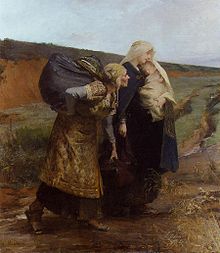Audovera
| Audovera | |
|---|---|
 Painting of Audovera's repudiation by Albert Maignan. | |
| Queens of Neustria | |
| Tenure | 561 - 567 |
| Born | c. 533 |
| Died | 580 Le Mans |
| Spouse | Chilperic I |
| Issue | Theudebert of Soissons Merovech Clovis Childesinda Basina |
Audovera (died 580) was the first wife or mistress of Chilperic I, king of Neustria.[1][2]
They had five children.
- Theudebert, killed in battle in 575 by Guntram Boso during the interminable conflict between Chilperic and his brothers.
- Merovech, married the widow Brunhilda, becoming his father's enemy. Killed by his servants on his own orders in 578.
- Clovis, assassinated by Fredegund in 580.[3]
- Childesinda, mentioned but once in the Liber Historiae Francorum as the infant whose botched baptism led to Audovera's dismissal. Committed to the same nunnery as her mother.
- Basina, nun, banished to a convent in 580.[4] She later led a revolt in the abbey of Poitiers in 589.[5][3]
Some time before 567, Audovera and Fredegund - then a servant of Audovera, but later to become another wife of Chilperic[6][7][4] - prepared for the baptism of Childesinda while Chilperic was away. Fredegund learnt that it was forbidden for a mother to receive her own child in her arms following a baptism, due to a canon law forbidding marriage between parents and godparents.[8] Fredegund arranged the events of the baptism such that Audovera unknowingly broke this taboo.[9][10] On Chilperic's return, Fredegund informed him of what Audovera had done. Chilperic committed Audovera to a convent in a rage. Fredegund later had her murdered in 580 to coincide with the assassination of Clovis and the exile of Basina.
References[edit]
- ^ Léglu, Catherine (March 2017). "The Vida of Queen Fredegund in Tote listoire de France : Vernacular Translation and Genre in Thirteenth-Century French and Occitan Literature". Nottingham French Studies. 56 (1): 98–112. doi:10.3366/nfs.2017.0170. ISSN 0029-4586.
- ^ Stafford, Pauline (January 1978). "Sons and Mothers: Family Politics in the Early Middle Ages". Studies in Church History Subsidia. 1: 79–100. doi:10.1017/S014304590000034X. ISSN 0143-0459.
- ^ a b Singer, Rachel (May 2022). "Gregory's forgotten rebel: the portrayal of Basina by Gregory of Tours and its implications". Early Medieval Europe. 30 (2): 185–208. doi:10.1111/emed.12534. ISSN 0963-9462.
- ^ a b Effros, Bonnie; Moreira, Isabel (2020-05-01). The Oxford Handbook of the Merovingian World. Oxford University Press. ISBN 978-0-19-023419-5.
- ^ Effros, Bonnie; Moreira, Isabel (2020-05-01). The Oxford Handbook of the Merovingian World. Oxford University Press. ISBN 978-0-19-023419-5.
- ^ Dailey, E. T. (2015-01-01), "7 Brunhild and Fredegund, ii: Queens, Politics, and the Writing of History", Queens, Consorts, Concubines: Gregory of Tours and Women of the Merovingian Elite, Brill, pp. 141–160, ISBN 978-90-04-29466-0, retrieved 2024-01-31
- ^ Wemple, Suzanne Fonay (2015-12-16). Women in Frankish Society: Marriage and the Cloister, 5 to 9. University of Pennsylvania Press. ISBN 978-1-5128-2133-8.
- ^ Jussen, Bernhard (2000). Spiritual Kinship as Social Practice: Godparenthood and Adoption in the Early Middle Ages. University of Delaware Press. ISBN 978-0-87413-632-6.
- ^ Wood, Ian N. (1998). Franks and Alamanni in the Merovingian Period: An Ethnographic Perspective. Boydell & Brewer. ISBN 978-0-85115-723-8.
- ^ Burgas, Gregory (2000). Legislating Against Reality : The Political Conflicts and Context of the Seventh-Century Merovingian Church Councils (Thesis). Portland State University Library. doi:10.15760/etd.3596.
